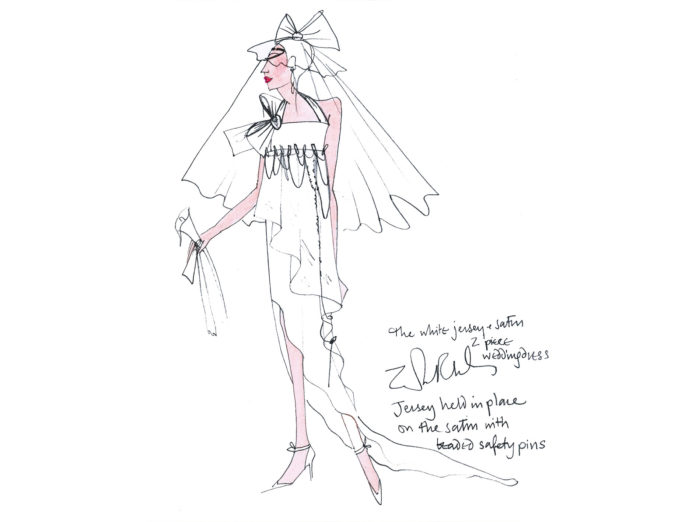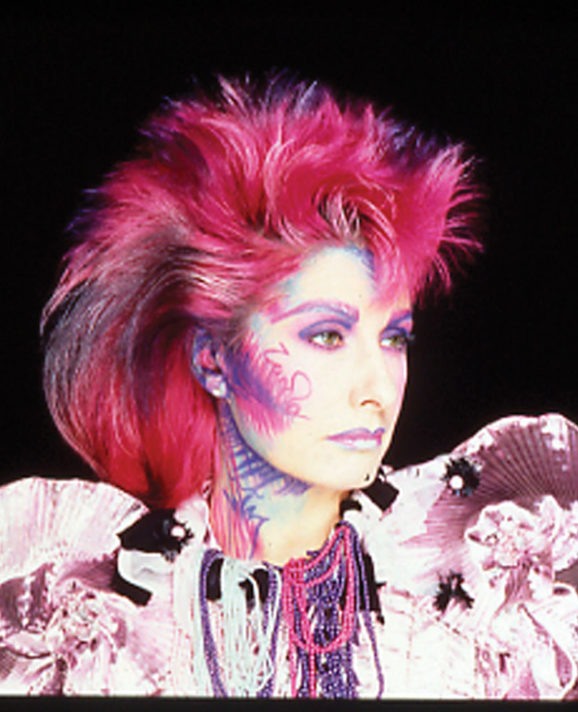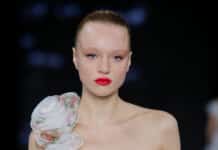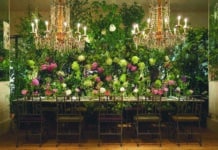
Bold and revealing, Zandra Rhodes’ torn wedding gown was the finale of her 1977 Conceptual Chic collection, not only marking a radical departure for the designer, but also introducing the punk zeitgeist into catwalk fashion
Words by Libby Norman
The year was 1977 and London’s punk scene was exploding. Enter Zandra Rhodes, certainly no stranger to counterculture, although during the mid 1970s she had become associated with – as she puts it – “beautiful flowing chiffons”. It was her fabulous fairytale white gown that was chosen for the 1973 Norman Parkinson portrait marking the engagement of Princess Anne and Captain Mark Phillip. A year before Conceptual Chic she had created a super-glamorous silk chiffon wedding dress (now in the V&A collection) for fellow fashion designer Elizabeth Emmanuel.
Her Conceptual Chic collection was a radical departure, picking up on what she felt was happening on London’s streets The main body of the collection featured plain jerseys embellished with holes, sink chains and safety pins and using a colour palette of red, shocking pink and black. After she created this one white gown, her then business partner Anne Knight said they had to make it a showpiece. And so the punk wedding bride became the finale of the show.

The wedding dress design was a two-piece construction combining a white jersey full-length skirt with train and a satin sash bodice – the halter neck and large bow were small concessions to romance. The jersey was attached to the bodice with safety pins and sink chains. The thigh-high side split revealed the legs, as did the artfully ripped and torn effects created by the holes in the skirt, with holes highlighted using black overlock stitching.
Reaction to the gown was, to put it mildly, mixed. US Vogue christened her “the Queen of punk” following the collection. But Zandra Rhodes recalls that the public were shocked by her Grafton Street (off Bond Street) store’s dramatic Conceptual Chic window display. She says: “Our customers didn’t want to know, so after about two weeks we quietly took the display down”.

“The gown was a statement piece – it is a classic in a weird way” Zandra Rhodes
Zandra Rhodes has acknowledged other influences beyond the punk revolution– notably the 1938 Tears Dress created by Schiaparelli and inspired by Dali. Today, she considers the Conceptual Chic collection among her personal favourites. She says: “The wedding dress is a classic in a weird way”.
While it was wildly ahead of its time – and was never worn by a real bride – its influence certainly lives on. Gianni Versace, who launched Elizabeth Hurley in ‘that dress’ with safety pins in 1994, openly cited Rhodes’ work as an inspiration. The wedding gown was also selected for the 2013 PUNK: Chaos to Couture exhibition at the Metropolitan Museum of Art, New York. It will be exhibited again at the Met from November to February at Masterworks: Unpacking Fashion – testament to the role of Zandra Rhodes’ daring punk bride in converting street movement into high-fashion concept.

About Zandra Rhodes DBE
Dame Zandra Rhodes studied at Royal College of Art and became famous from the late 1960s for her avant-garde designs and mastery of printed textiles, earning fans from Bianca Jagger and Freddie Mercury to Tina Chow, Jackie Onassis and Diana Princess of Wales. Since 2000, she has also been designing costumes for opera. She established London’s Fashion and Textile Museum in 2003 and was appointed Chancellor of the University of the Creative Arts (UCA) in 2010. Today she divides her time between homes in London and San Diego.




















